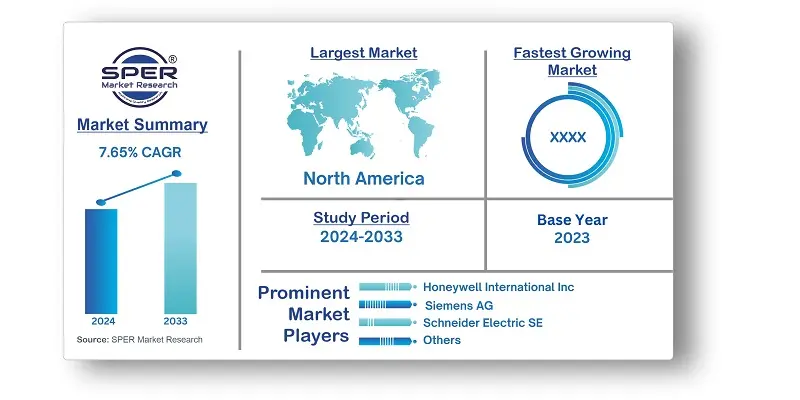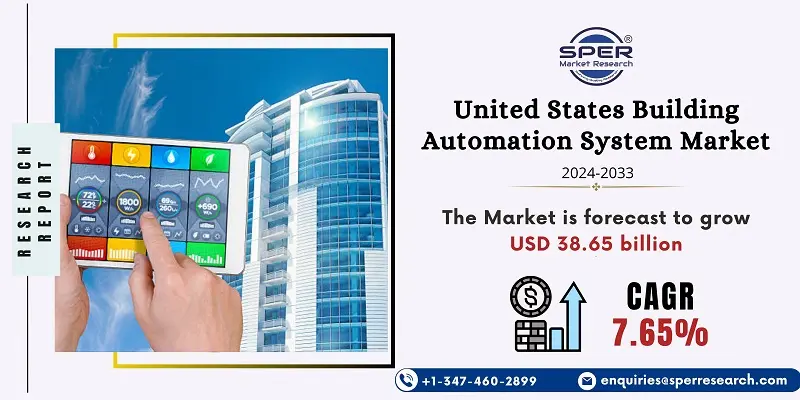
United States Building Automation System Market Trends, Share, Size, Demand and Future Outlook
United States Building Automation System Market Growth, Size, Trends Analysis- By Component, By Application, By Communication Technology, By End User- Regional Outlook, Competitive Strategies and Segment Forecast to 2033
| Published: Oct-2024 | Report ID: SEMI2430 | Pages: 1 - 108 | Formats*: |
| Category : Semiconductor and Electronics | |||
- Siemens launched the Connect Box in March 2023, a smart Internet of Things (IoT) solution for controlling small to medium-sized buildings. This user-friendly tool is part of Siemens Smart Infrastructure, which improves building performance monitoring, and is the most recent addition to the Siemens Xcelerator product range. It can increase energy efficiency by up to 30% while greatly improving indoor air quality in schools, retail establishments, flats, and small offices.
- Accenture and Johnson Controls announced their collaboration to create and manage two cutting-edge OpenBlue Innovation Centres in June 2022. By utilising innovations like artificial intelligence (AI), digital twins, the Internet of Things (IoT), 5G, and cloud computing, these centres will help Johnson Controls expand its use of building control system solutions. The main objective is to accelerate the adoption of sophisticated automation in building operations, with the ultimate goal of fostering improved user experiences, safety, security, and sustainability.


| Report Metric | Details |
| Market size available for years | 2020-2033 |
| Base year considered | 2023 |
| Forecast period | 2024-2033 |
| Segments covered | By Component, By Application, By Communication Technology, By End-User |
| Regions covered | Northeast, South, Midwest, West |
| Companies Covered | Honeywell International Inc, Siemens AG, Beijer Electronics, Schneider Electric SE, Reliable Controls, Johnson Controls International plc, Lutron Electronics Co, Inc, Automated Logic Corporation, Snap One, LLC, Crestron Electronics, Inc. |
- Commercial Building Owners and Managers
- Government Institutions
- Industrial Facility Managers
- Real Estate Developers
- Educational Institutions
- Healthcare Facilities
- Hospitality Industry
- Retail Chains and Malls
- Energy Management Companies
- Smart Home Technology Providers
| By Component: | |
| By Application: | |
| By Communication Technology: | |
| By End-User: |
- United States Building Automation System Market Size (FY’2024-FY’2033)
- Overview of United States Building Automation System Market
- Segmentation of United States Building Automation System Market By Component (Hardware, Software)
- Segmentation of United States Building Automation System Market By Application (HVAC Control Systems, Lighting Control Systems, Electronic Security & Safety, Building Energy Management System)
- Segmentation of United States Building Automation System Market By Communication Technology (Wired, Wireless, Others)
- Segmentation of United States Building Automation System Market By End-User (Commercial, Industrial, Residential)
- Statistical Snap of United States Building Automation System Market
- Expansion Analysis of United States Building Automation System Market
- Problems and Obstacles in United States Building Automation System Market
- Competitive Landscape in the United States Building Automation System Market
- Impact of COVID-19 and Demonetization on United States Building Automation System Market
- Details on Current Investment in United States Building Automation System Market
- Competitive Analysis of United States Building Automation System Market
- Prominent Players in the United States Building Automation System Market
- SWOT Analysis of United States Building Automation System Market
- United States Building Automation System Market Future Outlook and Projections (FY’2024-FY’2033)
- Recommendations from Analyst
1.1. Scope of the report1.2. Market segment analysis
2.1. Research data source2.1.1. Secondary Data2.1.2. Primary Data2.1.3. SPER’s internal database2.1.4. Premium insight from KOL’s2.2. Market size estimation2.2.1. Top-down and Bottom-up approach2.3. Data triangulation
4.1. Driver, Restraint, Opportunity and Challenges analysis4.1.1. Drivers4.1.2. Restraints4.1.3. Opportunities4.1.4. Challenges4.2. COVID-19 Impacts of the United States Building Automation System Market.
5.1. SWOT Analysis5.1.1. Strengths5.1.2. Weaknesses5.1.3. Opportunities5.1.4. Threats5.2. PESTEL Analysis5.2.1. Political Landscape5.2.2. Economic Landscape5.2.3. Social Landscape5.2.4. Technological Landscape5.2.5. Environmental Landscape5.2.6. Legal Landscape5.3. PORTER’s Five Forces5.3.1. Bargaining power of suppliers5.3.2. Bargaining power of buyers5.3.3. Threat of Substitute5.3.4. Threat of new entrant5.3.5. Competitive rivalry5.4. Heat Map Analysis
6.1. United States Building Automation System Market Manufacturing Base Distribution, Sales Area, Product Type6.2. Mergers & Acquisitions, Partnerships, Product Launch, and Collaboration in United States Building Automation System Market
7.1. United States Building Automation System Market Size, Share and Forecast, By Component, 2020-20267.2. United States Building Automation System Market Size, Share and Forecast, By Component, 2027-20337.3. Hardware7.4. Software
8.1. United States Building Automation System Market Size, Share and Forecast, By Application, 2020-20268.2. United States Building Automation System Market Size, Share and Forecast, By Application, 2027-20338.3. HVAC Control Systems8.4. Lighting Control Systems8.5. Electronic Security & Safety8.6. Building Energy Management System
9.1. United States Building Automation System Market Size, Share and Forecast, By Communication Technology, 2020-20269.2. United States Building Automation System Market Size, Share and Forecast, By Communication Technology, 2027-20339.3. Wired9.4. Wireless9.5. Others
10.1. United States Building Automation System Market Size, Share and Forecast, By End-User, 2020-202610.2. United States Building Automation System Market Size, Share and Forecast, By End-User, 2027-203310.3. Commercial10.4. Industrial10.5. Residential
11.1. United States Building Automation System Market Size and Market Share
12.1. United States Building Automation System Market Size and Market Share By Region (2020-2026)12.2. United States Building Automation System Market Size and Market Share By Region (2027-2033)12.3. Northeast12.4. South12.5. Midwest12.6. West
13.1. Honeywell International Inc13.1.1. Company details13.1.2. Financial outlook13.1.3. Product summary13.1.4. Recent developments13.2. Siemens AG13.2.1. Company details13.2.2. Financial outlook13.2.3. Product summary13.2.4. Recent developments
13.3. Beijer Electronics
13.3.1. Company details13.3.2. Financial outlook13.3.3. Product summary13.3.4. Recent developments13.4. Schneider Electric SE13.4.1. Company details13.4.2. Financial outlook13.4.3. Product summary13.4.4. Recent developments13.5. Reliable Controls13.5.1. Company details13.5.2. Financial outlook13.5.3. Product summary13.5.4. Recent developments13.6. Johnson Controls International plc13.6.1. Company details13.6.2. Financial outlook13.6.3. Product summary13.6.4. Recent developments13.7. Lutron Electronics Co., Inc13.7.1. Company details13.7.2. Financial outlook13.7.3. Product summary13.7.4. Recent developments13.8. Automated Logic Corporation13.8.1. Company details13.8.2. Financial outlook13.8.3. Product summary13.8.4. Recent developments13.9. Snap One, LLC13.9.1. Company details13.9.2. Financial outlook13.9.3. Product summary13.9.4. Recent developments13.10. Crestron Electronics, Inc13.10.1. Company details13.10.2. Financial outlook13.10.3. Product summary13.10.4. Recent developments13.11. Others
SPER Market Research’s methodology uses great emphasis on primary research to ensure that the market intelligence insights are up to date, reliable and accurate. Primary interviews are done with players involved in each phase of a supply chain to analyze the market forecasting. The secondary research method is used to help you fully understand how the future markets and the spending patterns look likes.
The report is based on in-depth qualitative and quantitative analysis of the Product Market. The quantitative analysis involves the application of various projection and sampling techniques. The qualitative analysis involves primary interviews, surveys, and vendor briefings. The data gathered as a result of these processes are validated through experts opinion. Our research methodology entails an ideal mixture of primary and secondary initiatives.



Frequently Asked Questions About This Report
PLACE AN ORDER
Year End Discount
Sample Report
Pre-Purchase Inquiry
NEED CUSTOMIZATION?
Request CustomizationCALL OR EMAIL US
100% Secure Payment






Related Reports
Our Global Clients
Our data-driven insights have influenced the strategy of 200+ reputed companies across the globe.




















